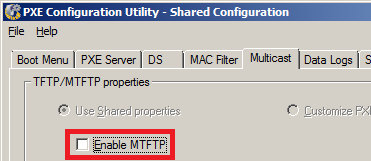 One of the more easier ways of speeding up your WinPE boot times via PXE are changing the default TFTP server which comes with Altiris. First of all, open up the PXE Configuration Manager and disable Multicast since the WinPE image cannot be transferred over Multicast anyway(only DOS supports Multicast via TFTP). This simple tweak shaves around a second off your PXE Boot time.
One of the more easier ways of speeding up your WinPE boot times via PXE are changing the default TFTP server which comes with Altiris. First of all, open up the PXE Configuration Manager and disable Multicast since the WinPE image cannot be transferred over Multicast anyway(only DOS supports Multicast via TFTP). This simple tweak shaves around a second off your PXE Boot time.
Another tweak which can be performed is changing the TFTP Server itself. This sounds quite difficult but is quite easy to accomplish and is a significant benefit. My own testing has shown that 10 Clients concurrently loading a WinPE image do it around 45-50% faster using another TFTP Server than if I was to continue using Altiris’s own server.
I was also going to cover compressing the WinPE image to reduce its file size, but found thatwhen doing so, the reduction in size was minimal shaving off around 10mb.
I’ll be using the Open Source Open TFTP Server, available from http://sourceforge.net/projects/tftp-server/. Download it and install it either on your Altiris Server or like I did, on my workstation and then copy it over to your server. You will also need to copy over your Settings file.
Firstly, open up the Services control applet and Stop the Altiris PXE MTFTP Server service.
Now comes the good part. Open an elevated command prompt. The following is based on our Altiris setup, with it installed on D drive and me creating a folder under PXE for OpenTFTP and pasting the OpenTFTP executable and Settings file into that folder.
sc config "Altiris PXE MTFTP Server" binpath= "D:\Deployment Server\PXE\OpenTFTP\OpenTFTPServerMT.exe"
That will reconfigure the MTFTP service path that Altiris uses to push out files from the Altiris supplied MTFTP to our Open TFTP server. You can go into the Services control applet and start the Altiris MTFTP service to begin using the new executable.
To try and get the most out of OpenTFTP server, have a play with the Settings file, primarly the blksize option. Ours is set to 1456 and can be changed depending on your network environment.
If for any chance you want to return to the Altiris MTFTP server then you simply need to run the sc config command pointing to your Altiris PXE MTFTP executable so stop the service again and enter the following into an elevated command prompt making sure to match the path to your Altiris location:
sc config "Altiris PXE MTFTP Server" binpath= "D:\Deployment server\PXE\PxeMtftp.exe"
Then start the service again and you are back to using the default Altiris multi-thread TFTP server.
This simple tweak shaves heaps of time off of WinPE (also Linux) automation boot times. If you are running the Dos based automation then there isn’t really a need to run this tweak as the transfer is small enough not to take long anyway.
Hope that helps.
It’s probably worth mentioning that the space after binpath= in your commands is vital – miss out the space and the sc config copmmand doesn’t work.